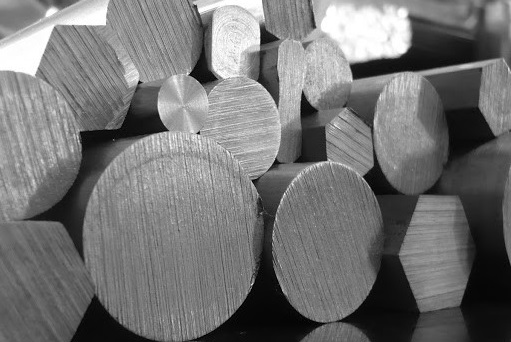What is Bright Bar?
Bright Bar can be made either by cold drawing, peeling or centerless grinding. As such a typical bright bar can be either drawn, peeled or ground or a combination of any or all the processes.
What is its source?
Hot rolled wire rods and bars from a variety of steel plants. The steel can be made available in Single / Double Rolled, Billet / Bloom Route, Hot Rolled, Soft Annealed, Spherodized Annealed, Normalized.
Why a bright bar?
A. As because hot-rolled bars have a large tolerance in diameter, ovality, and length cold bright bars can be provided with much closer tolerances.
B. Hot-rolled wire rods come is specified sizes, but bright can be made available to almost any size as desired.
C. As because hot rolled products have a scale on it as well as rough surface, Bright Bars are free of any scale and are bright in appearance.
D. Bright bars from the same source can be made available having different mechanical properties to suit different needs.
E. Bright bars are an intermediate product which is further processed for specific items like auto-components, machined parts, forging and so
What are the ground bars?
When a layer of the outer surface is removed by processing it on centerless grinders, this process is known as grinding and the product ground bars. Single cut can grind upto 0.10 mm.
What is the source?
Cold Drawn and or peeled Bars.
Why ground bars?
A. To achieve tight Dia. tolerance of 0.04 mm.
B. For those components where Zero Surface defect is required as it removes minor Cracks, Seems, Dents and Pitting etc.
C. Grinding is also must for the components which demands very good cosmetic look and / or plating is done.
What are peeled bars?
Peeling is the removal of the outer surface of Bars utilizing rotating tool bits. Single cut can turn 1 - 2 mm.
Why Peeled bars?
Surface defects are deeper and proportional to the diameter of bars. In large diameters removal of such defects is done by peeling wherein a deeper cut can be given. It is also feasible to attain the objective by grinding but it will take too many cuts to be carried out which is un-economic. Peeling leaves minor turning marks on the surface so often customers prefer to have Peeled and Ground bars.
What are shaped wires and bars?
Other than regular round a host of special sections like Hexagons, Octagons, Squares, D , Double D can be drawn. If it is in the form of Wire it is Shaped Wire and if in Bar form then it is Shaped Bar.
Why shaped wires and bars?
A. Cold-formed shaped products provide customers with the shape which otherwise would have to be done by machining.
B. It saves material wastage and hence costs.
C. Reduction in the number of processes that would have otherwise been used saves in costs, space and investment as well as lead time.
D. It can be supplied in Wire form if the customer has the continuous feeding process in their production line.
E. As it is cold formed so the metallurgical integrity is an added advantage over achieving the shape by machining.
F. The surface is bright and in exact shape and size so it can be directly processed for components like circlips and springs.
Quite often it is found that the surface of bright bars gets rusty. Can this be taken care of?
The exposed surface of cold drawn bars is very sensitive to surface degradation by way of corrosion. Corrosion is aggravated by the following factors:
A. Moisture in air
B. Temperature
C. Exposure to a corrosive environment.
D. Amount of cold reduction To take care of this, rust preventive oil is applied to the finished bars. This oil comes in various grades and utility.
E. For material that is intended to be used up within a week, solvent-based rust preventive oil is used.
F. For a longer shelf life say 30 days or more a lube based rust preventive oil can be used.
G. For material that requires protection for a shorter period but does not require oil on it for various reasons, dry or semi-dry film based oil fortified with corrosive inhibitors can be used.
H. For the export market where a sea-worthy packing is required, we do have the option of wrapping each bar with either polythene film or paper which is coated with non-toxic volatile corrosion inhibitors.
I. Even bright bars can be oiled and packed in polypropylene packets to improve shelf life.
J. However, it should be remembered that all these efforts can delay the process of corrosion by providing a finite shelf life but can never stop corrosion.
If I ask for bright bars of say 18 mm diameter with % C 0.40 – 0.50 and % Mn 0.50 – 0.90, what will you supply me?
You have asked a very pertinent question as we do get a lot of orders as such. In such case we will supply you cold drawn bright bars as under:
A. Supply will be as per the available steel whose ladle analysis will conform to the chemistry provided by you. The relevant grades are EN-8D, EN-43B, AISI 1041 – 1046, IS C-40, IS C-45, JIS S43 – S48, DIN Ck-45.
B. The diameter will remain in between 17.91 – 18 mm.
C. The length will be between 2750 – 2800 mm.
D. It will be smeared with solvent-based rust preventive oil whose shelf life is 30 days.
E. The bright bar packet will be almost 1 MT in weight and will be tied at two points by annealed wires. The packet will be dispatched without any packaging if the consignee is in the National Capital Territory of India. For outstation customers, this bright bar packet will be wrapped with a polypropylene sheet and loaded in a truck having a waterproof canvas.
